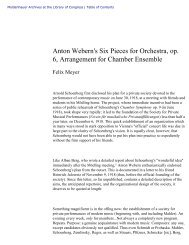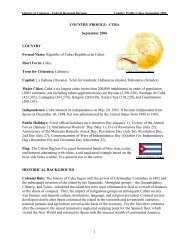1 - American Memory
1 - American Memory
1 - American Memory
You also want an ePaper? Increase the reach of your titles
YUMPU automatically turns print PDFs into web optimized ePapers that Google loves.
177<br />
«.3 percent In Norember and 6.f) percent by February—the bigbest rates expe-<br />
rienced since 1954, and the first period since 1956 when Hawaii's unemployment<br />
rate exceeded the national averajse.<br />
And finally, transportation interruptions often send prices soaring at a time<br />
when Hawaii's families can least afford it. The impact of these strikes on<br />
Hawaii's consumer prices Is well documented l)y the consumer price and food<br />
price indexes compiled by the U.S. Department of Labor's Bureau of Labor<br />
Statistics.<br />
Consumer prices in Hawaii climbed 3 percent during the May-October local<br />
dock strike in 1949, while nationally prices declined slightly.<br />
The effect was even greater during the 100-day West Coast dock strike In the<br />
third quarter of 1971. Even with Pliase I of the wage-price freeze in effect begin-<br />
ning mid-August. Honolulu food prices jumped 4.5 percent between June and<br />
October. By contrast. I'.S. fof)d prices declined 0.3 percent over the same period.<br />
The major reason for the sharp increase in food prices was that grocery chains<br />
were forced to airlift fresh produce from the Mainland at much higher freight<br />
costs. The higher transiwrtation costs were pa.ssed on to consumers because raw<br />
agricultural products were exempted from price controls. The fruits-and-vege-<br />
tables price Index for Honolulu vaulted 8.2 percent In August 1971 and 5.3 per-<br />
cent In September, while nationally these prices declined 1.9 percent In August<br />
and 5.7 percent in September. Hawaii's fresh produce prices normally would have<br />
followed this seasonal decline.<br />
The same pattern of rising food prices appeared when the 1971 dock strike<br />
was resumed in January 1972 after the Taft-Hartley cooling-off period, and<br />
again during the strike of the Masters, Mates and Pilots Union In the fall of<br />
1972.<br />
Price indexes are academic, but the effect on the pocketbook Is not. How<br />
many Mainland families would have been willing to pay 72(t for a head of lettuce,<br />
$1.45 for a dozen oranges, or $2.28 for 10 pounds of potatoes in February 1972?<br />
Yet in Hawaii, where salaries are generally no higher than on the Mainland,<br />
these were the average prices families had to pay—or do without.<br />
These effects are most pronounced during a long transportation stoppage, but<br />
It should be realized that it isn't just long transportation strikes that hurt<br />
Hawaii. Short strikes are short strikes only in retrospect; they could turn into<br />
long strikes, and they trigger the response that a long strike would provoke:<br />
stockpiling, boarding, panic buying, etc. And even the threat of a strike that<br />
never comes off Is only a threat in retrospect: when the threat looms on the<br />
horizon, businessmen and consumers adopt a here-we-go-again attitude and a<br />
resulting behavior pattern that can be as costly and disruptive as would l>e<br />
the case if the strike ultimately occurred.<br />
The conclusion is clear: Hawaii must somehow And her way out of this pre-<br />
carious situation that she has been in for so long.<br />
CHAPTER III—WHAT To Do?<br />
We have seen in Chapter I that Hawaii is completely dependent on water-<br />
borne commerce and air transportation. We have seen In Chapter II that dock,<br />
maritime, and airline strikes have in fact brought Hawaii, economically speak-<br />
ing, to her knees on many occasions. Now let us ask and answer In this chapter<br />
what should, can, and must be done about this.<br />
Out of all the froth and debate on this subject, three proposals seem to stand<br />
out. They are:<br />
PROPOSAL A<br />
Amend Taft-Hartley and the National Railway Labor Act so that they could<br />
be applied to regional or local emergencies, rather than only to national emer-<br />
gencies.<br />
PROPOSAL B<br />
Make a major revision of Taft-Hartley ha.sed upon experience with these two<br />
acts over the decades and Include railroads and airlines under this act rather<br />
than under the Railway Labor Act.<br />
PROPOSAL o<br />
Pnsh for special legislation that would exempt Hawaii from dock or maritime<br />
strikes and national airline strikes.



![Albert Einstein Papers [finding aid]. Library of Congress. [PDF ...](https://img.yumpu.com/21604228/1/190x245/albert-einstein-papers-finding-aid-library-of-congress-pdf-.jpg?quality=85)





![American Colony in Jerusalem Collection [finding aid]. Library of ...](https://img.yumpu.com/17941275/1/190x245/american-colony-in-jerusalem-collection-finding-aid-library-of-.jpg?quality=85)



![Piccard Family Papers [finding aid]. - American Memory - Library of ...](https://img.yumpu.com/17941234/1/190x245/piccard-family-papers-finding-aid-american-memory-library-of-.jpg?quality=85)


